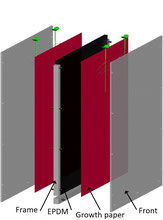Root Phenoboxes with Enhanced Growth Resistance
Root Phenobox Phenotyping System

Root Phenobox. Root phenoboxes were developed in order to efficiently determine realistic genotypic differences in rooting patterns of crops, inspired by the HT RhizoChamber Monitoring platform (Wu et al., 2018). Similar to the classical growth pouches and ready-to-use seed pouches, phenoboxes allow sequential imaging of roots growing in a soil-free HT phenotyping system. The root phenobox design is described below in greater detail. In brief, roots grow along transparent acrylic (PMMA) panels (front and back) in front of a woven fabric, membrane or germination paper of choice. A middle layer of 'spongy', elastic EPDM removes gaps and gently presses the growing paper / fabric against the transparent panels - creating an enhanced growth resistance.

The Root Phenobox combines the qualities of classic germination pouches/growth-pouches and sophisticated Rhizotubes(TM) approaches by providing a more rigid, highly reproducible environment for soil-free root phenotyping, while avoiding soil effects as in rhizobox approaches. By offering two imaging sides, each root-phenobox can hold at least two root systems (one from each side), and is thus space efficient for placement under controlled environments. A constant space between two sheets of transparent PMMA ('acrylic') is created by black PMMA spacers ('frame'), the thickness of which is carefully chosen to match the thickness of the EPDM and the growing paper (when wet). The lower spacer has cut-outs to allow free drainage. A sheet of elastic ethylene-propylene-diene monomer (EPDM) is placed in the centre between the two acrylic panels to provide an even, light pressure on the roots - avoiding gaps between the cloth/paper and the acrylic window and thus preventing / reducing preferential root growth along gaps. This results in increased growth resistance to the developing root systems, rendering root establishment more realistic. Phenoboxes can be top-fertilised; the solution is then infiltrated through the growing paper/cloth etc. Alternatively, the bottom of the germination paper / fabric can be tapped into a water reservoir, as in a "classic" growth pouch. Due to their rigidity, the system can be integrated into high throughput phenotyping platform - as demonstrated (Wu et al., 2018). Phenoboxes (and optional PhenoRacks, Shading Panels) are fully customised - please get in contact.
Root Phenobox - Features
- Germination paper-based root phenotyping with growth resistance
- High throughput ready
- Provides advanced protection to root systems
- Adaptable to a large range of species
Options
- Large selection of Accessories (PhenoRacks, Shading Panels etc)
| References | Root Phenoboxes | OPEN |
|
||
Considerations for Custom Phenobox Designs
- The root phenobox creates a more 'natural' growth resistance for the developing root systems by effectively eliminating air gaps between the growing paper / cloth and the acrylic front panels. To design your custom-made phenobox, please consider .. Show more
-
- Internal/external dimensions (w x h x d) (depending on the species (size, growth rate), duration of trial, space in the growth chamber, etc.) and size of germination paper / membrane available (to avoid resizing, choose at least 3-4 mm larger on all sides for materials that expand when wetted).
- Material used as 'growing medium' - i.e. germination paper or other (reusable?) cloths or membranes (not included).
- Plants that develop thick roots may require a thinner or softer EPDM material and/or thicker frames to avoid excessive pressure during root growth. Consider the thickness of germination paper or membranes when wet.
- Larger seeds may require a void in the EPDM to avoid over- compression of the hydrated seed.
- Wrap the EPDM in cling film for easy cleaning & long-term use.
In summary, you may wish to test your future high throughput phenotyping system with different root phenobox configurations to adapt it to your target plant species. We suggest including a range of EPDM materials (varying in thickness and softness) for initial trials with the target species to optimise the root phenotyping process.
For classic soil-free phenotyping platforms - using germination paper without growth resistance - please see our types of growth pouches available in plain (plastic sleeves) and rigid variants.
See sterile, ready-to-use germination pouches for immediate soil and hassle-free root phenotyping and plant bioassays in the lab.








